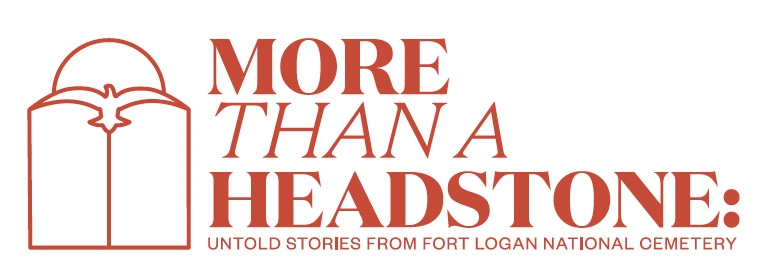“He Belongs at Fort Logan”
By Catherine Cecil
Joseph Enoch Burns
September 26, 1900 - April 20, 1977
Joseph Burns’ legacy may easily have been lost to history had it not been for his steadfast, lifelong friend.
Flag being lifted from Joseph E. Burns’ casket at his full military honors service at Fort Logan National Cemetery. (Photo courtesy of Denverpost.com.)
In 1900, Joseph was born in Longmont Colorado[1] to Anna M. Hickman Burns and barber-by-trade, Dennis Millard Burns.[2] Both parents were from Missouri and had begun to raise their family there. The entire family moved to the Berthoud area after 1890 when Joseph’s sister, Dorothy, was born.[3] In 1903, Anna died of fever, leaving behind her infant son and the rest of the family to a new Coloradoan life.[4]
Just a few months before his 19th birthday, Joseph enlisted in the U.S. Army. He served from July 1, 1919, to June 30 1922, where he was a Private First Class in the immediate post-war period.[5] The First World War closed at Germany’s signing of an armistice in November of 1918, and the post-war climate and order was solidified by the Treaty of Versailles, signed just two days after Joseph joined the ranks of the U.S. Army.[6] While the Army quickly demobilized, critical military legislation was passed to maintain some peacetime numbers. However, immediately after World War I, the U.S. Army still maintained forces in several areas.[7]
After Burns was discharged in 1922, he enlisted again, but in the Navy from 1925 to 1928 where he served in Nicaragua.[8] The United States had forces in Nicaragua beginning in the Taft administration in classic observance of Dollar Diplomacy and increased in the Wilson administration, justified by American interests in Latin America, particularly the protection of the Panama Canal.[9]After a brief removal of forces in 1925, U.S. occupation returned under President Calvin Coolidge which backed Nicaraguan politician Adolfo Díaz and an embargo which prevented arms from getting into the hands of political opposition.[10] Though Burns was again discharged in 1928, the U.S. didn’t remove forces from Nicaragua until 1933.[11]
Upon leaving the service, Joseph Burns returned to Denver and began work as a physical laborer.[12] By the 1940s, Burns had never married and many family members in the area passed away or moved to different corners of the United States, though he was still close with his father, Dennis, who lived in Berthoud, until his passing in 1943.[13] He was living as a lodger in Denver and worked at the City Municipal Water Works when the Second World war broke out and he continued work as a laborer in different capacities.[14]
In the Spring of 1977, Joseph was in a Denver nursing home from injuries inflicted during a robbery.[15] He died alone in the nursing home on April 20th. Burns never married, had no children, and had no known relatives, so he immediately became a welfare case under the Denver Social Services Department.[16] The welfare burial unit informally asked Fort Logan National Cemetery to see if Burns was a veteran. Fort Logan officials ended up having Joseph’s fingerprints cross-referenced with military records to confirm his eligibility to rest at Fort Logan, but they were too late. The mortuary which handled his welfare burial process had already let Burns slip through administrative cracks.[17]
Sharon Tulk, relative of Joseph Burn’s friend Ben Tulk, kneeling beside Joseph’s unmarked grave prior to disinterment and being moved to Fort Logan. (Photograph courtesy of Denverpost.com.)
Joseph was buried on April 29, 1977 in Riverside Cemetery, in a grave marked by a tin oil can with the number 34 on it.[18] A Denver Post article explained that “at the time Burns died, he had virtually no clothes and apparently was to be buried in a winding-sheet.[19] Luckily, Burns’ friends rushed in a suit for him to wear instead. The mortuary service successfully applied for and received an American flag for Joseph’s burial, but it wasn’t used.
Four friends of Joseph’s attended his burial but protested when they found out that there was no standard concrete liner in his gravesite, his casket was damaged and dirty, and there wouldn’t be any graveside rites before he was lowered at Riverside. His burial would bear no semblance to the respect promised to veterans at the end of their lives.[20]
Ben Tulk, Joseph’s long-time army buddy, advocated against Burn’s burial process and treatment by the various Denver administrations which let Joseph fall through the cracks of paperwork into an unmarked grave. In Tulk’s opinion, even “if [Joseph] was never in the service, he didn’t deserve the kind of burial he got...I think they treated him kind of dirty.”[21]
Marge Drew, Joseph Burns’ niece, accepts her uncles’ flag at his funeral with military honors. (Photo courtesy of Denverpost.com.)
Ben Tulk and his family members continued to push the Colorado Division of Veterans Affairs, the funeral home, and Fort Logan to confirm Joseph’s veteran status. Under this pressure, George Winner, the assistant direct of the Colorado Division of Veterans Affairs, found confirmation that Burns had indeed served in the Army and the Navy.[22] Winner explained that bureaucracy was often getting in the way of proper military honors, noting that the Denver Social Services welfare burial department hadn’t checked with his VA department about deceased veterans for over ten years.[23]
To right the wrong that Tulk’s family fought to uncover, Winner made the decision to disinter Joseph from Riverside and have him instead buried at Fort Logan with full graveside military honors, explaining that he was “fighting bureaucracy.”[24]
Ben, Clara, and Sharon Tulk all attended the ceremony on July 21, 1977. Marge Drew, Joseph’s only known living relative who he had never met, accepted the American flag after Army Chaplain Charles P. Carlson gave graveside services.[25]Through the Tulk family’s tireless efforts to give Joseph Burns a dignified and deserved military burial, the man who died seemingly all alone was finally laid to rest, with chosen family by his side.













